Studio blog
News and updates about Tom Phillips, posted by the artist himself
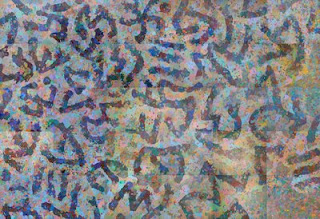
As at 31.10.2008
At art school we worked in silence. When eventually I graduated to independent studio life it occurred to me that listening to music would enhance the day: my LPs of Beethoven and Bartok string quartets could be just the thing. I was wrong. If I listened I stopped painting and if I painted I failed to listen, hearing just the first few familiar bars but only becoming aware of the piece again as the final cadence gave way to the hiss of needle on vinyl.
But priorities are priorities and I was always able to pay attention to the Test Match commentaries. Far from hindering concentration the spoken word seemed to take up the slack of a brain that would otherwise have inwardly burbled on about money and quotidien anxieties. When rain stopped play it was a double blow, although, as in winter, there was always BBC drama to look forward to after lunch.
Why not the mornings? Each day somehow seems a fresh embarkation with the chart to consult and a course to be plotted to negotiate once more the way out of dock and harbour. Towards the end of the morning (coincidentally when cricket also gets underway) the wordmind dwindles in its usefulness.
Changes in the wireless schedules drove the BBC plays to a less convenient time so I learned to record them for later consumption. Using cassettes brought me only a step away from the talking book, to which I am now addicted. Peckham library may be short on Trollope and Henry James but it is rich in literature I knew little about and I thank them for Elmore Leonard, Elizabeth Jane Howard, Lee Child, Dennis Lehane and those others who have sustained the doze-prone artist through long afternoons.
Working on this painting has clarified for me how much music is embedded in what I do and why its actual presence in the studio has never been a help. I have made drawing and paintings over the years that refer to music directly and even use the graphic devices of notation, staves, barlines, note-clusters etc. Sometimes as in Last Notes from Endenich these can arrive at a virtually playable score
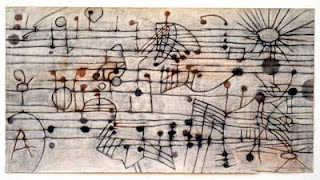
Last Notes from Endenich, pastel h75cm x w150cm 1975.
and at others, using the same elements, as in Concerto Grosso, they evoke for me an imagined music that lies, for a technically limited composer, beyond my reach to realise.
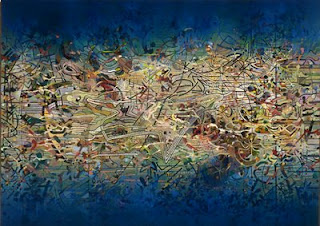
Concerto Grosso, oil on canvas h91cms x w122cms 2002.
Quantum Poetics on the other hand, while it carries no such specific baggage, has deep musical roots that have spread strongly as it has progressed. All along it has had the feel of a symphonic structure with motifs and variations. Its soundscape has suggested a divided orchestra with the dark areas represented by cellos and lower wind instruments and the lighter background provided by the higher strings and woodwind. These, which never play together, are linked by a viola and horn continuo (with interjections sometimes harsh sometimes soft from the percussion) representing the intrusions and extrusions of the main calligraphy. I do not claim that this great orchestra strikes up whenever I start to paint but often it swims into the mind's ear. More than a few times I have sung along either in my head or out loud.
Now, just as I approach the final chimes of a cadence to mark its end, I am off again to watch the red and amber leaves fall on Einstein Drive at the Institute for Advanced Study in Princeton. This will seem as if the conductor has suddenly put his baton down and quit the podium before the piece achieves its proper resolution. It is because, were he to turn the next page of the score he would find it blank. I hope to come back with the last few notes.
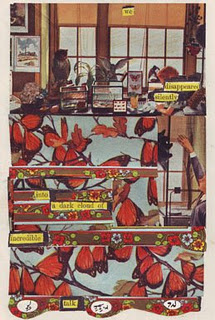
November 1 – December 12, 2008
SFU Gallery, Burnaby Campus
Panel Dicussion: Saturday November 1 at 2pm*
Opening + book launch: Saturday November 1 following symposium, until 5pm
Monica Aasprong · Andrea Actis · James Arthur · Oana Avasilichioaei · Derek Beaulieu · Jen Bervin · Rebecca Brown · Louis Cabri · Steve Collis · Jeff Derksen · Alexandra Dipple · Sarah Dowling · Jennifer Borges Foster · Jamie Hilder · Kristin Lucas · Michael Maranda/Parasitic Ventures Press · Erin Mouré · Tom Phillips · Kristina Lee Podesva · Angela Rawlings · Mary Ruefle · Susan Schuppli · Nick Thurston · Aaron Vidaver
Erasure is much in the news these days—stock portfolio values erased, a neighbourhood buried under water by storms, candidates for office learning that the public chose someone else, or a Fortune 500 company ceasing to exist. Erasure, however, has another side that deserves to be in the news: the poetic and the critical. This is the side reflected in this 24-person international exhibition, which includes the first-ever installation of the entirety of Tom Phillips’s book A Humument.
The poets, writers, and artists in Less is More have each responded to the ironic, formal, political, and semantic possibilities that awaited liberation from the source material they elected to use. The resulting poetry can take many forms: paintings, modified books, vinyl lettering on walls and floor, or blacked-out government documents.
Erasure is the most serious way that playfulness has emerged in recent art. By modifying existing documents and artifacts in aid of reconsidering their meaning, erasures provide an intriguing model for the ways in which meaning is created in the first place; it is epistemology, with fun added.
Panel discussion, Opening, Book Launch: Saturday November 1, 2pm
Please join us for a panel discussion on “The Poetics and Politics of Erasure” with Derek Beaulieu, Clint Burnham, Kristina Lee Podesva and Nick Thurston. Panel starting at 2pm, in room AQ3003, next to SFU Gallery. Followed by reception to 5pm.
*Note that the panel discussion was originally advertised as starting at 1pm, but the time has been changed to 2pm.
Publication:
This exhibition is accompanied by a 144-page book co-published as the exhibition catalogue and as an issue of The Capilano Review.
Lunchtime talks at 12:05pm and 12:35pm on:
Wed Nov 5, Thurs Nov 6, Fri Nov 7
Talks for classes or groups may be scheduled by appointment at 778.782.4266 or gallery@sfu.ca.
FREE PARKING! November 1 only. The exhibition card, media release, or Erasure exhibition page from our website is your visitor parking pass in any Visitor Lot at SFU (face up on dashboard or hand to parking attendant).
Contact and information:
The SFU Gallery is located at the SFU Burnaby Campus, AQ3004 (in the Academic Quadrangle, south side); Hours: Tues-Fri 10am-5pm, Sat 12pm-5pm. We are closed for holiday long weekends.
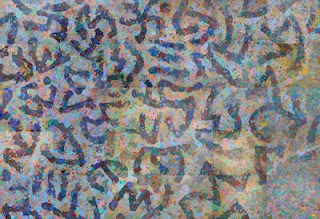
As at 17.10.2008.
To all my Canadian readers. If either of you finds yourself in Vancouver on Nov 1st you are invited to the opening of Erasures which features the whole of A Humument.
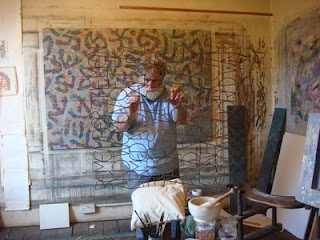
Advances on the Western front of my painting have been slowed by diversionary manoeuvres in the studio as I grapple with the last stages of preparing the memorial for Westminster Abbey. As mentioned previously we no longer speak of war. Hence this Conflict Memorial will be unveiled, with much fanfare and bemedalled dignitaries in full uniform, by a royal personage on the 29th October.
After much sieving and grinding with pestle and mortar I have my pigment ready, a mixture of earth from the world's battlefields. It is tricky to paint on round sectioned wire with its four dimensions, back, front, sides and the bit-out-of-sight-one-always-seems-to-miss.
Meanwhile at the Abbey itself, locked in a little worker's lean-to, Phil Surey is chipping away at the cloister wall to carve the lettering that frames the metal centrepiece.
It is uneasily strange to be celebrating warfare (I have not yet learned to say conflictfare) but the artistic problems remain the same; of probity in design, truth to materials and the combination of these with propriety to the subject, to present a unity.
Asked to make a statement describing the work for the upcoming occasion I tried to imagine what would make sense for the bereaved (and the comrades and friends) of the fallen, for whom the memorial should carry most meaning.
This memorial takes the form of a text (adapted from that provided by the Armed Services Memorial committee) worked in welded steel so that the letters of which it is made support and strengthen each other in free space. With this structural interdependence and the presence of steel, the generic material of ordnance, a military metaphor is tacitly present. This is symbolically reinforced by the overall covering given to the metal which is made up from earth gathered world-wide (with the assistance of travelling friends) from various sites of conflict. These date from 1066 (Battle itself) via Agincourt, the Somme and onwards to the present day. Fifteen such earth samples were mixed and ground together to make a pigment bound in colourless acrylic resin. Thus, in an echo of Rupert Brooke's famous poem, "some corner(s) of a foreign field" are brought to an appropriate place to indicate the long ancestry of national courage. The not unexpected resemblance in colour and granular texture to rust could be thought quietly to voice the artist's hope of an ultimate peace. Framing the metal sculpture and beginning similarly with the all important word 'remember' is the motto of the Armed Services Memorial Appeal carved into the fabric of the Abbey itself, a stone that is the same as that used throughout the world by the War Graves Commission. The carving is made as deep as is practicable to catch the maximum amount of defining shadow.
The services and their dead are memorialised in bonded steel, camouflaged in the earth of battle, with a surrounding call to remembrance marked in sanctified stone.
I am of course invited to the ceremony though, looking at the embossed card I am not sure what, for an artist, 'full dress uniform without sword' might be.
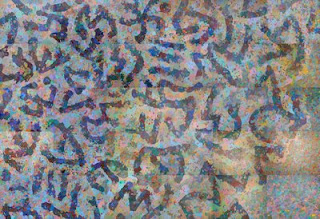
As at 1.10.08
An encouraging thing about the painting is that, for all its pleas for revision, it does begin to benefit from its barmy method of execution.
As I had hoped it really offers two distinct experiences for anyone looking at it. Moreover these almost contradictory perceptions cannot quite be had simultaneously. Thus it protects itself from at-a-glance appraisal by the casual spectator (or lazy critic).
From any distance it reads as a relatively simple image of large calligraphic shapes floating in a variegated ether of lighter colour. Close up however it presents a continuum. Both light and dark areas are inhabited by ornament on a scale that keeps itself more or less a secret from even a few feet away.
A crucial part of the game (and every work must have the combative playfulness of a game) has been, from early on, to explore what Owen Jones described in the title of his unwieldy and wonderful Victorian tome The Grammar of Ornament. I have always regarded ornament as a high art - as distinct from decoration which is added to something rather than being the matter from which it is made.
Ornament often goes hand in intricate hand with script both in the great illuminated pages of Christian illumination and the masterpieces of Arabic art which respond to the restrictive anti-representational challenge of Islam.
One of my art school tutors said of some work I was doing that it was 'just like knitting'. He meant this to be caustically damning but, as time went by, I realised that what is originally seen as a fault in one's work can be its particularity; something that should be intensified rather than adandoned. So here I am, fifty years later, knitting again and with unflagging enthusiasm for the variations that can be performed on the themes of net and maze, interlace, foliation and meander. A thousand streams of influence come into play in this abstract vocabulary.
One such I am daily reminded of at the moment as I prepare my long delayed book (promised two years ago to Hansjörg Mayer) on Akan goldweights of which I have an embarrassingly large collection. These miniature bronzes, some figurative but most abstract, were used by the Asante (Ashanti) for weighing the gold dust that was their currency for many centuries. They exhibit a rich repertoire of ornamental strategies as in this sample group of the miniature boxes (cast via the lost wax process) for carrying an individual's tiny packages of gold.
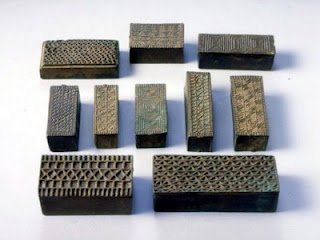
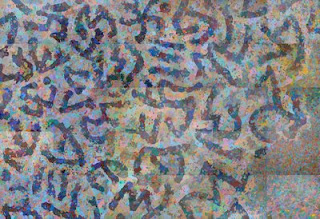
As at 23.9.08
Approaching endgame on the painting. Nervous times. There is always the fear of the image merely falling off the eastward edge it has been surging towards so slowly and for so long. The last elements have to conspire not only to sustain the momentum but to make sure the viewing eye is persuaded to travel back into the choreography of signs.
The analogy with ballet is not inappropriate: the problem on the theatre's dancing stage is to perpetuate the action: the corps de ballet has to command the whole territory. Its larger actions head towards the wings with strategies for return.
Stage, force field, battleground, microscopic slide, astronomical image, book-page, monumental inscription, diagram, weather system, planetary surface, map, musical score... all these and other ways of imagining my picture in its boundaries occur to me. Most constant is the dialogue between the microscopic and telescopic; that I am visually inhabiting either a minute event in the subatomic world or a huge one on the gigantic slow cinema screen of the cosmos. The other analogy most frequently invoked is, as here, the dance.
I once saw the dance of life and death, briefly and by accident. Opening the wrong door in an apartment block in Havana I chanced upon a young couple in a completely bare room dancing the tango to a quiet gramophone. They did not notice my entry and I watched the grey clad figures seeming to flit through each other, merging as they parted, separating as they drew together; all noiselessly with unhurried speed. After a few minutes I quietly shut the door on that entrancement but have been haunted by their magic motion ever since.
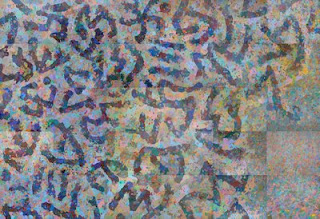
As at 9.9.08
My friend David S, who is trying to have his unofficial portrait painted, occasionally looks over at my picture. Once, glancing at it while sitting, he asked "What happens if you make a mistake?" The only answer is the standard philosopher's escape clause, "It depends what you mean by 'mistake' ".
Since the painting is an improvisation following neither drawing or (as in a portrait) objective event, mistakes are difficult to define.
On both the level of detail and of the larger design every mark compensates for the one before, nudging the balance this way and that, as instinct leads me. Each mark is in a sense a mistake that has to be corrected by the next. This, in turn, will be corrected by its successor to restore the equipoise of the part and the whole. Like tightrope-walking it is an endless sequence of adjustments (I recommend the film Man on Wire for those who want to see art in its final form and purest beauty of madness and risk.)
The whole painting is in one sense made of mistakes. One is reassured by looking at the Michelangelo crucifixion drawings done at the end of his life, when he faced the fact that outlines do not occur in nature. These little epics are battlegrounds of indecision in which the uncertainty principle visits art before it finds a home in science. They are compounds of truthful error that quiver before the eye.
Two other possible questions suggest themselves, one too metaphysical and the other too cruel to contemplate:-
What if the picture makes a mistake?
and...
What if the painting is itself a mistake?
Yet David S is a part-time jazz trumpeter and is therefore aware that there are no mistakes in jazz - if one sounds a false or split note one immediately repeats it to show that it was deliberate. In painting as in jazz there is both need and room for creative bluff.
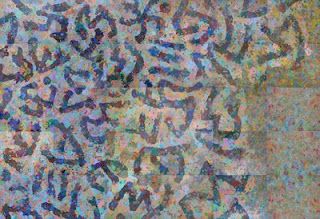
As at 27.8.08
However I am asked to be there, a shadowy presence at a bells and smells occasion much looked forward to. All readers welcome.
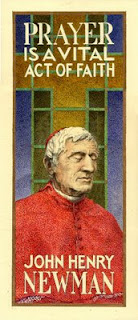
Study for mosaic of Cardinal Newman, 2007.
Quite early on in the evolution of my painting, at the point where I decided to expand from the panel that seeded it early last summer (see blog July '07), it became itself an act of postulation. In short, not to be bashful, I postulated a masterpiece, albeit a flawed one by this all too human hand.
Masterpiece is a word that hardly dare speak its claim. It is the pcitorial equivalent of sainthood, alhtough it originally signified a work which proved to the guild of St Luke that one had graduated from apprentice to full membership of the profession.
Now as I near the eastern edge of my painting I see the gap between postulation and confirmation. Decisions have become more significant. The picture has acquired so much identity that any move that does not comply with its implicit rules and constraints, or that shows a misprision of its rhythm and dance, will break what spell it has. I now spend more time staring at the picture than actually painting it. Like John Henry Newman it needs a miracle or two.
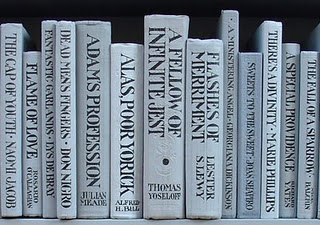
Tom Phillips installation work The Library at Elsinore, will be the centrepiece of an exhibition at the Shandy Hall Gallery this autumn. Amongst the exhibits are six new pages from A Humument completed especially for this exhibition. The show will run from 22nd September to 30th November and all readers are invited to the private view to meet the artist on Sunday 21st September between 11am and 3pm. A special Elsinore Library blog has been created as a resource for schools who will be working on projects associated with the exhibition.
Shandy Hall Gallery
Laurence Sterne Trust
Shandy Hall
Coxswold
York YO61 4AD
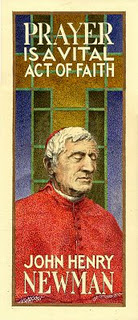
On Wednesday September 10 there will be a formal unveiling and dedication of a new mosaic by Tom Phillips of John Henry Cardinal Newman at Westminster Cathedral. The dedication will take place after the 5.30pm Mass to which all are welcome.
Illustrated here is a study for the mosaic.
Archives
- 2020
- December (1)
- 2019
- June (1)
- 2017
- March (1)
- 2015
- November (1)
- February (1)
- 2013
- September (1)
- August (2)
- February (2)
- 2012
- October (1)
- August (1)
- July (4)
- June (1)
